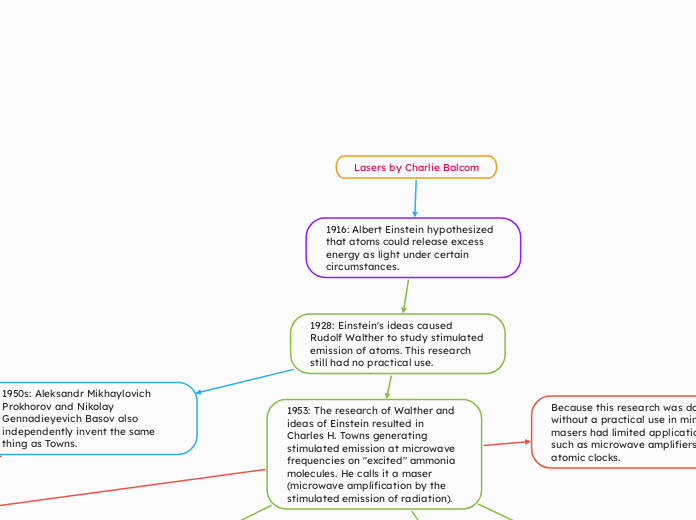Dec: 1960: Ali Javan, William Bennett Jr. and Donald Harriot build the first gas laser (helium neon laser) which fires a continuous infrared beam. The invention of helium neon lasers led to many different technologies being invented because the laser beam was visible.
Red lines = Related to a specific event/events
Blue lines = Chronological order
Green lines = Causally related
Key:
Mid 1970s: Lasers become used large scale in supermarket checkouts
1969: Laser target designators guide smart bombs to their targets
1979: Lasers become used for CD audio players and laser printers
Late 1980s - Early 1990s: Eye surgeons begin to use pulses from ruby lasers to weld detached retinas back together
1960s: Laser pointers are used in lecture halls
Lasers begin to have diverse applications as a result of the boom in research and development in the late 1950s and early 1960s.
1962: One of the first helium neon laser uses was projecting straight lines for alignment in construction.
1963: Emmett Leith and Juris Upatnieks make holograms with lasers
Lasers by Charlie Balcom
1916: Albert Einstein hypothesized that atoms could release excess energy as light under certain circumstances.
1928: Einstein's ideas caused Rudolf Walther to study stimulated emission of atoms. This research still had no practical use.
1950s: Aleksandr Mikhaylovich Prokhorov and Nikolay Gennadieyevich Basov also independently invent the same thing as Towns.
1964: All three scientists win Nobel Prizes for Physics
1953: The research of Walther and ideas of Einstein resulted in Charles H. Towns generating stimulated emission at microwave frequencies on "excited" ammonia molecules. He calls it a maser (microwave amplification by the stimulated emission of radiation).
May 1960: Inspired by the research of Towns, Theodore H. Maiman fires pulses from a photographer's flash lamp exciting chromium in synthetic ruby producing red pulses.
Lasers become popular because they are similar to the "heat rays" of science fiction
Late 1950s: Gordon Gould invents his own laser ideas and coins the word laser.
Gould speculates that lasers will become powerful enough to cut and drill through materials
Dec 1958: Towns and his brother-in-law Arthur L. Schawlow publish ideas for an "optical maser" with shorter wavelengths of infrared or visible light.
Towns and Schawlow speculate that lasers will be used to send signals through air or space
Because this research was done without a practical use in mind, masers had limited application such as microwave amplifiers and atomic clocks.

